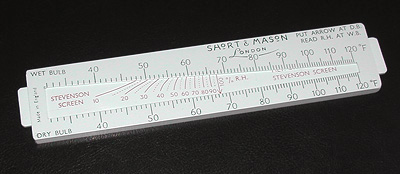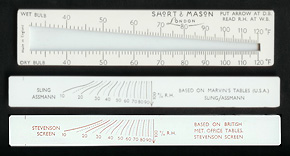 |
|
|
|

|

|
Psychrometric slide rule |
|
|
|
|
One nice thing about HOC collecting is that you get to learn unexpected new things from remote domains of Science that you’d normally never hear about. Like Psychrometry, for instance. |
|
|
|
amazingly simple: you pass the air across two thermometers, one
whose sensing bulb is dry, the other with a bulb covered in wet
cloth. The evaporation of water will cool the wet bulb, lowering the
thermometer’s reading to an extent dependent on the humidity of the
air, the ambient temperature, and other parameters of the system. Different models of psychrometer differ by the method used to pass the air rapidly across the two bulbs. An Assmann psychrometer uses a motorized fan; a sling psychrometer puts the two thermometers in a tube that can be manually whirled through the air at the end of a rope or similar device; another type of psychrometer measures the temperatures in the still air in a ventilated chamber called a Stevenson Screen. The calculation of relative humidity is not straightforward and varies from model to model; it has to be done with semi-empirical formulas, embodied in software, charts or slide rules adapted to each psychrometer. The slide rule before us was made for this purpose by Short & Mason, a British manufacturer of meteorological instruments. |
|
|
|
“Newton’s formulas”. Physics is physics; the weather is more
like magic, and has many spells... So how does this thing work? Say your sling psychrometer shows a reading of 80 degrees Fahrenheit on the Dry Bulb, and 70 degrees on the cooler wet bulb, after you whirl it vigorously in the air. You insert the slide with the Sling / Assmann side up, and set its down pointing arrow to point at 80 on the Dry Bulb (lower) scale -- as in the photo below. Now you look at the 70 mark on the Wet Bulb (upper) scale, and see that it’s aligned with the curve marked 60 on the slide: the relative humidity is therefore 60%. You can see in the same photo that had the wet bulb read 75 degrees, the R.H. would have been 79%; and with the wet bulb at 80 -- same as the dry one, indicating no cooling at all -- the humidity would’ve been 100%. Quite easy, really, and it hides the complexity of the underlying relationships behind the pre-determined shape of a few curves! |
|
|
|

|
|
|
|
Home | HOC | Fractals | Miscellany | About | Contact Copyright © 2006 N. Zeldes. All rights reserved. |
|

